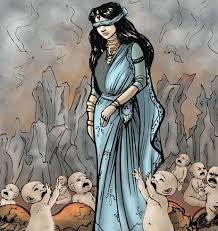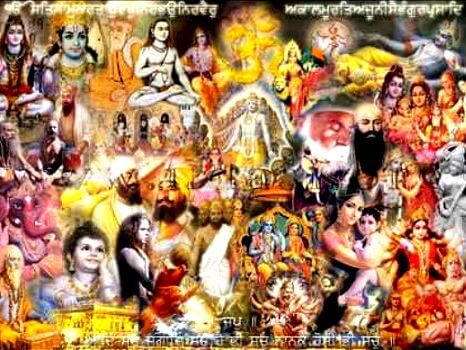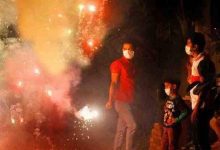Ruchira takes us into the enchanting world of mythology, exclusively for Different Truths.
 Our country possesses a rich repertoire of mythology and legends. These transcend barriers of time, space, language and region; their appeal to human hearts is spontaneous and universal.
Our country possesses a rich repertoire of mythology and legends. These transcend barriers of time, space, language and region; their appeal to human hearts is spontaneous and universal.
Prior to the internet revolution as well as advent of dish antenna-cable television combo, mythology was an inextricable part of lives of ordinary folks. Children of each generation through the 60’s and up to the 70’s (I can wager) had their grandmothers and/or elderly aunts narrating mythological stories to them. During weekends, holidays and more so during summer vacations this used to be a highly popular pastime.
Little kids gaped in wonder upon being told how queen Gandhari (of Mahabharata fame) gave birth to 101 children; that in Ramayana King Dasharath’s three wives having consumed a bowl of sanctified food had four sons between them.
What a vast canvas! Little kids gaped in wonder upon being told how queen Gandhari (of Mahabharata fame) gave birth to 101 children; that in Ramayana King Dasharath’s three wives having consumed a bowl of sanctified food had four  sons between them. Or how Dasharath unleashed an ultrasonic-like missile which killed the youthful Shravan instead of a deer at a watering hole.
sons between them. Or how Dasharath unleashed an ultrasonic-like missile which killed the youthful Shravan instead of a deer at a watering hole.
Then there are rakshasas (demons) and daitya-danavas (giants) galore almost in every tale. For instance young Ramachandra slew Tadaka. Much later Lakshmana slashed the nose of Surpanakha (Ravana’s sibling) while the artful Hanuman cleverly dodged Singhika, while traversing the ocean on his way to Lanka with the Gandhamadan hillock. Who can forget Kumbhakarna who lay fast asleep for one half of each year? During the other half in “awakened” state his only task was to devour anything and everything that came handy. Turning to other genres beyond the epics e.g Puranas, Sri Sri Chandi et al one finds the goddess Durga in her myriad manifestations slaying demons like Raktaveeja and Mahisasura. Or for that matter we have the dapper and playful Krishna (alter ego of Lord Vishnu) annihilating Mura, Madhu and Kaitava in different eras.
There is so much more in the treasure trove of mythology which fires the imagination of the readers especially children who read or hear the anecdotes. The pushpaka rath (literally: flying chariot) transports the rider anywhere through the skies; mythical figures ride pakshiraj the winged horse to reach far-flung places in a jiffy.
There is so much more in the treasure trove of mythology which fires the imagination of the readers especially children who read or hear the anecdotes. The pushpaka rath (literally: flying chariot) transports the rider anywhere through the skies; mythical figures ride pakshiraj the winged horse to reach far-flung places in a jiffy. There are copious references to Pashupat Astra and Brahmastra that bear uncanny resemblance with the (lethal) nuclear armaments of modern times. One stumbles across half human-half avians, the likes of Garuda and Jatayu, brigades of nearly-human apes (Vanara) commanded by none other than Hanuman. There are deities and demi-gods armed with four-eight-ten arms, three eyes, three-five visages . Talking of heads, the little ones are tickled pink to learn how Ganesha the most genial of the deities, gets his head replaced by that of a pachyderm, after the original was severed by Lord Shiva, in a fit of fury.
The mythical world is also peopled by Nagas – serpents possessing immense powers. The most prominent ones include Vasuki Ananta (aka. Shesh nag) on whose massive corpus, Lord Vishnu is depicted as reclining, Kaliya who is eventually slain by Krishna, Uloopi one of Arjuna’s numerous wives, not forgetting Manasa,Shiva’s daughter who is venerated till date.
Durvasa was notorious for cursing anyone who dared displease him. Agastya commanded respect to such a degree that (so the legend goes) the Vindhyachala mountain in central India, agreed to stay with bowed head, until the sage returned from his journey down south, which he never did.
As a child I would be awestruck to observe how numerous rishis and munis wielded considerable clout over the lives of people from royalty to ordinary. Durvasa was notorious for cursing anyone who dared displease him.  Agastya commanded respect to such a degree that (so the legend goes) the Vindhyachala mountain in central India, agreed to stay with bowed head, until the sage returned from his journey down south, which he never did. (It was a ploy to curb its upward expansion). Vishwamitra and Vashishtha, more amiable and less formidable were known to have officiated as kulpurohits (priests) of royal families. They also taught archery and warfare techniques to young princes.
Agastya commanded respect to such a degree that (so the legend goes) the Vindhyachala mountain in central India, agreed to stay with bowed head, until the sage returned from his journey down south, which he never did. (It was a ploy to curb its upward expansion). Vishwamitra and Vashishtha, more amiable and less formidable were known to have officiated as kulpurohits (priests) of royal families. They also taught archery and warfare techniques to young princes.
In successive ages the most outstanding sages were assigned a place in the hall of fame, up in the firmament. As we all know the Great Bear is hailed as Saptarshi (seven rishis) in the Indian vernaculars. The Dashavatara (ten incarnations) of Vishnu also prove interesting. Vishnu’s assumption of diverse forms – fish, tortoise, boar among many– to rescue the distressed, fires the readers’ imagination.
A strong element of symbolism is palpable too. Manifold arms of deities signify strength and power. The extra eye is considered fountainhead of knowledge, while more than one head depicts sagacity wisdom and creativity.
All said and done, mythology does have an intrinsic value beyond entertainment and knowledge. For one, it portrays to what heights and depth human imagination can soar, how will power, determination, mental prowess can make or mar lives of others around us. A strong element of symbolism is palpable too. Manifold arms of deities signify strength and power. The extra eye is considered fountainhead of knowledge, while more than one head depicts sagacity wisdom and creativity. Above all, inclusion of the divine, human (mortals), and living creatures of all shapes and sizes within a single gigantic frame indicates an eternal cosmic harmony which is the ultimate truth of life.
Photo from the Internet






 By
By
 By
By
